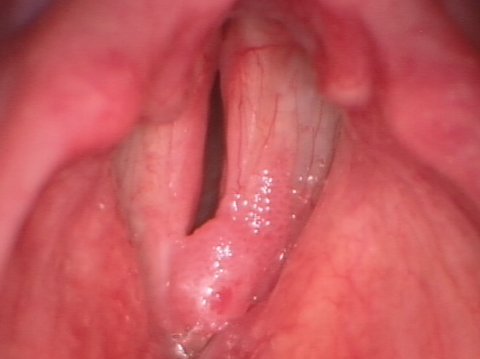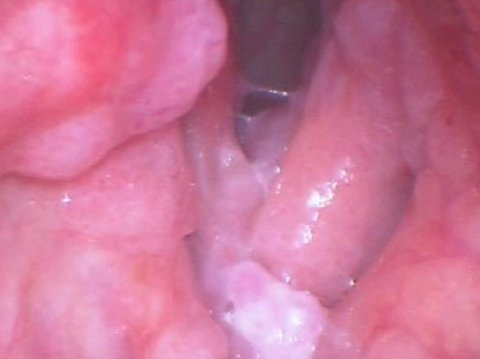What is laryngeal papillomatosis?
Vocal papillomas or vocal fold papillomas are mostly benign lesions, typically presenting with a cauliflower-like or characteristic “bunch-of-grapes” appearance. Under higher magnification, there are detectable vascular protrusions, called villi, which bleed when pressure is applied to them.
Vocal fold papillomas can occur in isolation. However, they are usually found in larger formations or widely spread across the tissue. In extreme cases, laryngeal papillomatosis can affect the entire vocal fold region and grow into the airway passages.
Vocal papillomas are subdivided into two forms. The first — called juvenile papillomatosis — primarily affect children. The age peak lies between 4 and 6 years of age. The second form affects adults. The age peak lies between the third and fifth decade of life.
Medium-sized vocal papilloma


How does laryngeal papillomatosis develop?
Vocal papillomas develop from a viral disease triggered by the human papilloma virus (HPV). Although a large proportion of the population is infected with HPV viruses, only few patients suffer from the typical symptoms, at a rate of two to three per 100,000 persons.
The HPV causing laryngeal papillomatosis can be classified into different virus subtypes. This subdivision is especially important because it allows classification of the presenting pathologies into low-risk and high-risk types.
The low-risk types caused by the HPV subtypes 6 and 11 are the most common. With these types of HPV, the risk of malignant progression is rather rare. Patients with the high-risk types must get more frequent check-up examinations due to the higher malignancy rate.
Extensive papillomatosis


What symptoms are caused by laryngeal papillomatosis?
- Mild to pronounced hoarseness
- Rapid vocal fatigue
- Impairment of breathing
Since laryngeal papillomas are usually localized on the vocal folds, the primary earliest symptom is a more or less pronounced hoarseness of the voice. The degree of hoarseness will correspond with the size of the vocal papilloma.
In advanced forms of the disease, laryngeal papillomatosis can also extend into the airway passages, thereby causing a comparable degree of respiratory symptoms and shortness of breath.
Because these papillomas usually grow faster in small children and the diameter of their larynx is smaller, impairment of breathing can be expected earlier in this age group.

What treatment options are available?
- Voice surgery
- Pharmacotherapy
- Immunization
The therapy of choice for treating vocal papillomas is their phonosurgical excision. Note must hereby be taken that laryngeal papillomatosis is a viral disease and that therefore the papillomas tend to grow back despite the most highly qualified surgical interventions. The phonosurgical options for managing vocal papilloma are described in greater detail in the section Voice Surgery for Laryngeal Papillomatosis.
Besides surgical treatment, drug therapy to suppress the virus is another option that has been available for many years now. This involves injecting a drug (Cidofovir ©) into the papillomas during surgery.
This treatment method for recurrent respiratory papillomatosis has been described to lead to a lower relapse rate in some patients. In Germany, cidofovir has not yet been approved for use in the treatment of vocal papillomas, making only off label-use possible.
Another treatment option available for recurrent respiratory papillomatosis is vaccination against the HPV virus. This type of vaccination was originally developed to treat cervix cancer, but is meanwhile also recommended as vaccination against the HPV virus in laryngeal papillomatosis. A tetravalent vaccine is available for subtypes 6, 11, 16 and 18. These are the virus subtypes isolated most frequently in patients with laryngeal papillomatosis. We have observed in our patients that vaccination with the tetravalent vaccine can postpone the recurrence rate, or relapse propensity, of the disease in many instances.
Example of phonosurgical treatment for vocal fold papillomas
Vocal fold papillomatosis before surgery
Vocal fold papillomatosis after surgery

Truths and Myths About Laryngeal Papillomatosis
Laryngeal papillomatosis is not primarily a malignant disease, although the sometimes abnormally rapid growth of papillomas gives that impression. Nevertheless, in high-risk types, malignant changes to the cells can occur. Therefore, regular follow-up examinations along with histological studies are necessary for these types.
It must be pointed out that no matter how efficient the surgery and no matter how skilled the surgeon there is no 100% guarantee that the patient will be cured of the disease. Because laryngeal papillomatosis is a viral disease, recurrences can occur at any time, particularly when the patient’s immune system is impaired.

Case Report: Laryngeal Papillomatosis
Over a period of several months, this 29-year-old rock musician had been noticing problems with his voice. His voice was hoarse with pitch breaks; he had increasing complaints when speaking; his singing voice had lost its quality, particularly in the high range. When he presented, he had been virtually unable to sing for six weeks.
The patient was a non-smoker and did not have any other diseases relevant to the symptoms.
The videostroboscopic examination by his ENT specialist revealed substantial cauliflower-like changes on both vocal folds. The vibrations of his vocal cords were almost completely absent on both sides, his voice quality was hoarse, his average speaking pitch was markedly lowered. He was no longer able to sing.
The patient was recommended to undergo a phonosurgical procedure. In a single session, the visible papillomatous lesions were then surgically removed from both vocal folds by delicate dissection. After two weeks of voice rest, the vocal folds exhibited remarkably good vibratory behavior; vocal fold closure was for the most part complete.
His voice quality was strong and clear and his average speaking pitch was markedly higher. The patient perceived his voice as pleasant and the quality of his singing voice was back to the level of six months prior. The patient was advised to get a postoperative vaccination with a tetravalent vaccine.




